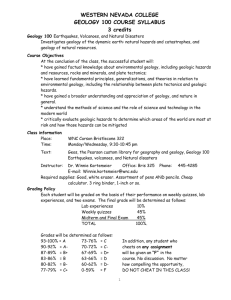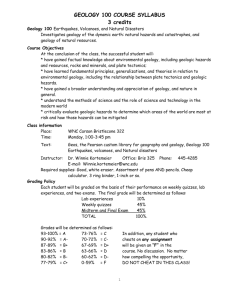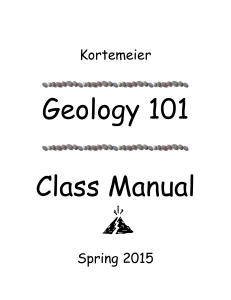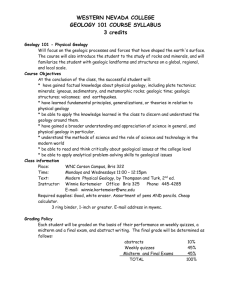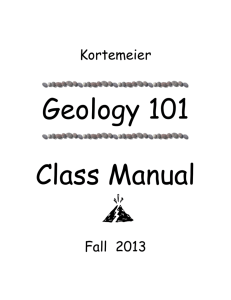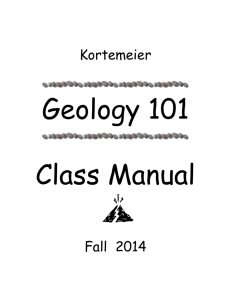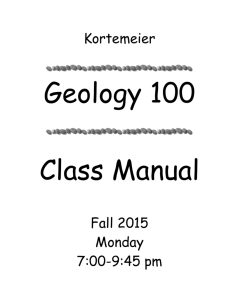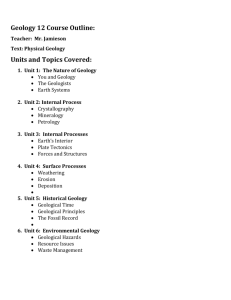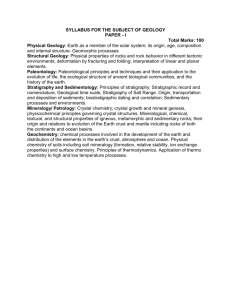Geol 101 1001 - Western Nevada College
advertisement
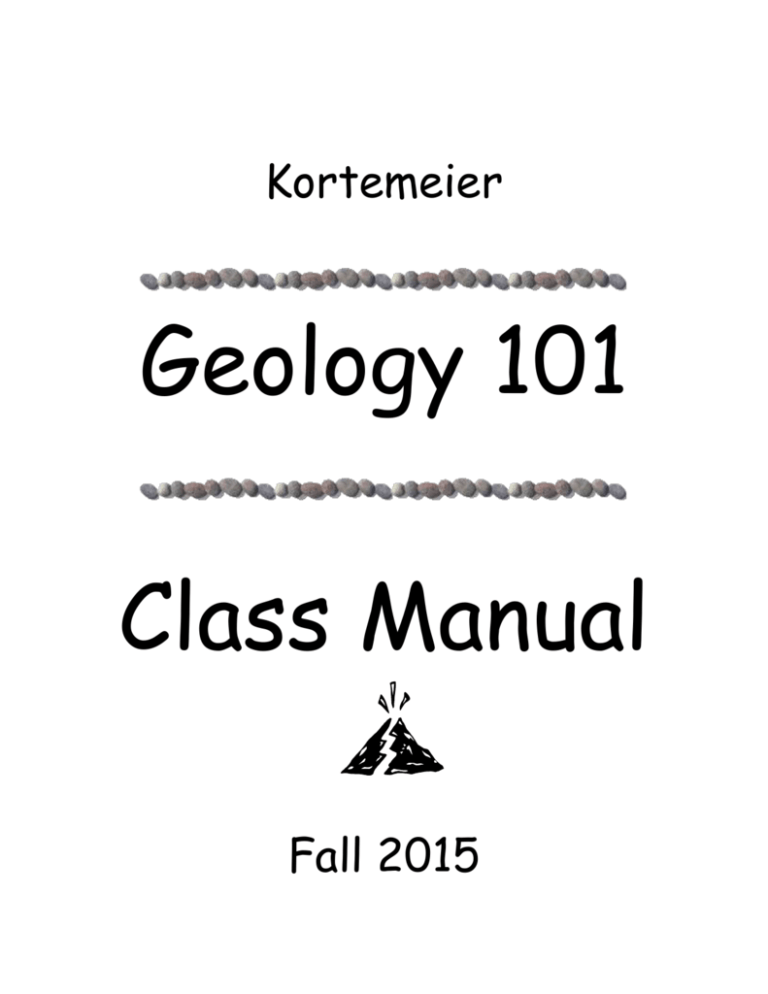
Kortemeier Geology 101 Class Manual Fall 2015 Western Nevada College Physical Geology Geology 101 Dear Geology 101 student, Hello! And welcome to Geology 101, Physical Geology, You have chosen a great class! (even previous students say so). Have you ever wondered what "those rocks" are as you drive down the road? Could a volcano really erupt in Los Angeles? Is your house or apartment on an earthquake fault? Could a tsunami hit California? Stick around, we'll find out. I guarantee that, after this class, you'll never look at the earth the same way again! My name is Winnie Kortemeier. You may call me Winnie, Dr.Winnie, Dr. Kortemeier, or Professor Kortemeier, your choice. I pretty much love rocks - they all have very interesting stories to tell. I've got a Bachelors degree (Furman University in South Carolina), a Masters degree (Arizona State University), and a PhD (UNR ,finished last December) all in geology. Before I started teaching, I worked for a mining company and a land survey company doing (you guessed it) geology among other things. I'm also married to a geologist (well rounded person, huh?). Geology is great fun, but it is a science. So we'll be studying rocks scientifically. And that means that, while we will have fun in this class, you will also work hard. You will need to be able to devote study time to this class EVERY WEEK. How much time will vary greatly from individual to individual, but I can guarantee that it will need to happen every week at some point. (This class greatly discourages procrastination.) In return for your hard work every week, I promise to never give you "busy-work", to always let you know what is expected of you, to help you succeed in your course goals, and to open your eyes to the geology around you. Sincerely, Winnie Kortemeier Geoscience Professor Western Nevada College 2 WESTERN NEVADA COLLEGE GEOLOGY 101 COURSE SYLLABUS 4 credits Geology 101 - Physical Geology Lecture covers fundamental principles of geology: tectonics; minerals; igneous, metamorphic and sedimentary processes; and geologic time. Lab covers reading of topographic maps, study and identification of common rocks and minerals, and the study of geologic phenomena. Course Objectives Upon successful completion of this course, students should be able to: 1. Use terminology specific to the geologic topics selected for the course. 2. Use geologic concepts and principles to demonstrate a working knowledge of earth processes. 3. Apply classifications to categorize geologic features and phenomena relevant to the topics selected for this course. 4. Perform laboratory activities that demonstrate the ability to apply key physical geology concepts and principles. Class information Place: WNC Carson Campus, Bris 322 Time: Mondays and Wednesdays 11:00 – 12:15pm, Wednesdays 1:00-3:45 Text: Modern Physical Geology, by Thompson and Turk, 2nd ed. Instructor: Winnie Kortemeier Office: Bris 325 Phone: 445-4285 E-mail: winnie.kortemeier@wnc.edu Required supplies: Good, white eraser. Assortment of pens AND pencils. Cheap calculator. 3 ring binder, 1-inch or greater. E-mail address in mywnc. Grading Policy Each student will be graded on the basis of their performance on weekly quizzes, a midterm and a final exam, and abstract writing. The final grade will be determined as follows: Lab quizzes 25% abstracts 7% Weekly quizzes 34% Midterm and Final Exams 34% TOTAL 100% 3 Grades will be determined as follows: 93–100% = A 73-76% = C 90-92% = A70-72% = C87-89% = B+ 67-69% = D+ 83-86% = B 63-66% = D 80-82% = B60-62% = D77–79% = C+ 0-59% = F In addition, any student who cheats on any assignment, quiz or test will be given an “F” in the course. No discussion. No matter how compelling the opportunity, DO NOT CHEAT IN THIS CLASS! Attendence, Make-up Policy, and General Information The abstracts will consist of approximately 3 short reports using on-line resources. The abstracts will be due one week after being assigned. See Abstract Instructions in this syllabus. Abstracts may be turned in up to one week after the due date, but late assignments will be marked down 20%.. The midterm and final will consist of multiple choice (50% of test) and paragraph answer questions (50% of test) covering ½ of the semester each. The material is taken from the class notes, questions and hints, abstracts, quizzes, and the chapters in your book. You are allowed to bring an 8 ½ x 5 ½ piece of paper (1/2 of a regular sheet of paper), material on one side only, to each test with any information on it that you desire. If you cannot be present for the midterm or final, you are required to contact me before the test is administered to schedule a make-up time. The make-up test must be taken (in my office and with me present) before the next scheduled class. In addition, make-up tests may not be allowed the use of the 8 ½ x 5 ½ piece of paper filled with notes. The quizzes will be given weekly, and will be completed on-line. The material for the quizzes will be from the class notes and the Questions and Hints in your class manual. They will be open book and open note, but will be timed and must be the student’s own work. You will have approximately 1 week to complete each quiz. Quizzes canot be made up if missed, but I will drop the lowest quiz grade at the end of the semester. You cannot pass this class if you are not able to complete the quizzes each week! You may also substitute a field trip report for one quiz grade. Field trips to be announced later. Do your best to attend every scheduled class session. . If you must be absent, remember that YOU are responsible for all missed course work and assignments. It is best to contact one of your classmates for this information. All course paperwork is in your class manual, so bring it to every class period. Attendance is the key to a successful learning experience in this course! If you have a disability for which you will need to request accommodations, please contact the Disability Support Services office (Carson Campus, Bristlecone building, Room 103) as soon as possible to arrange for appropriate accommodations. 4 Some “Don’ts” Cell phones need to be put away and turned off for the entire class. No chewing tobacco No meals. Drinks and cold (non-smelly) snacks are OK. Laboratory How lab works: Every week, students will work together to complete a lab assignment. Students will check their lab work with a key available in the classroom. After making sure the assignment is thoroughly understood, students will take the assignment home for reference for the following week's quiz. At the beginning of the next week’s lab, an open-book quiz will be completed covering the previous week’s assignment. Quizzes are completed individually. Grading: The lab grade will be determined by averaging the scores on the weekly quizzes. There are no tests, midterm, or final. If absence is unavoidable, quizzes may be made up the week following the absence. Weekly quiz grades = 25% of grade in class We must all suffer one of two things: the pain of discipline or the pain of regret and disappointment 5 OFFICE HOURS See schedule below for office hours. Other hours by appointment. Just call or email me. I'm also in my office many other hours of the week and you are welcome to drop in to see me at any time. Dr. Winnie’s Fall 2015 schedule 9:3010:45 am 11:00 12:15 am 1:00 pm 2:00 pm Monday Tuesday Wednesday Thursday GEOL 100 Bris 322 9:30-10:45 Geol 101 Bris 322 11:0012:15 Office Hours 9:30-11:00 Geog103 Bris 322 11:0012:15 GEOL 100 Bris 322 9:30-10:45 Geol 101 Bris 322 11:0012:15 Office Hours 9:30-11:00 Geog 103 Bris 322 11:0012:15 OFFICE HOURS 1:00 – 3:00 GEOL 100 Bris 322 1:00 – 345 Geol 101 Lab Bris 322 1:00-3:45 Friday Meetings and appointmen ts as scheduled 3:00 pm 4:00 pm 7:00 pm 9:45 pm Geol 100 Bris 322 7:00-9:45 6 7 8 Geol 101 Kortemeier Fall 2015 COURSE OUTLINE WEEK Topic READING 1. Introduction /Plate Tectonics Chap. 2 2. Chap. 2 Monday = Holiday Plate Tectonics 3. Plate Tectonics/ Atoms and Minerals Chap. 2/3 4. Atoms and Minerals Chap. 3 5. Atoms and Minerals/Igneous Rocks Chap. 3/4 6. Igneous Rocks/Plutons and Volcanoes Chap. 4/5 7. Plutons and Volcanoes Chap. 5 8. Monday = Midterm Exam Wed = Weathering Chap. 6 9. Sedimentary Rocks Chap. 7 10. Metamorphic Rocks Chap. 8 11. General Rocks Wed = Holiday 12. General Rocks/ Geologic Time 13. Geologic Time Chap. 8 Chap. 9 Wed = Holiday 14. Geologic Structures Chap. 12 15. Earthquakes Chap. 10 16. Final Exam 9 Student's role in Geol 101 Be in class. On time too! The more you are here, the better your grade will be. Guaranteed. Take thorough notes. If I talk about it, it's fair game for quizzes and tests. But don't try to write down what I say word for word. You'll kill yourself. And it's usually in the book anyway. Keep material organized. In addition to your manual, you’ll need to organize tests, handouts, field trip notes, etc Take part in class. Ask questions, answer questions, work with your classmates. Smile or nod every once in a while. Your sleeping or inattention bothers me. If you miss a class, call a classmate to find out what you missed and to get notes. Contact me to get materials you need. Be prepared for the next class. Study for your quizzes and exams. Read the book, go over your notes, talk to a classmate. Tests and quizzes are your opportunities to show me what you are learning. Don't miss these opportunities to "strut your stuff". When I'm lecturing, pay attention. Talking to your classmates distracts me and the other students. Treat instructor and classmates with respect. Know what Winnie Cows represent. Instructors role in Geol. 101 Answer all questions so that students understand. Talk slowly enough and with enough pauses so that students can take thorough notes. Be available in office, by telephone and by email to help students. Show students that science is FUN. Help students develop good study and learning habits. Treat all in classroom with respect. Be prepared and on time for class. Facilitate discussions. Draw good Winnie Cows. 10 Instructions for Completing One-Page Abstracts One-inch margins all around 12 pt font, no bold fonts 30-35 lines of text, no more, no less At least 4 sources, on-line OK. One can be wikipedia, NOT “google”. Reference and cite every bit of information you write. Use this format: Within abstract, cite like this: The 2.0 my volcanic rocks around Tahoe City interacted with an early Lake Tahoe. The water-rock interactions formed tuff rings at several locations on the ProtoTahoe shoreline (1). At end of abstract, references should look like this: References: (1) Kortemeier, Winifred, 2008, Young Basalts at Lake Tahoe Show Water-Rock Interaction, GSA Abstracts with Programs, vol. 27, p. 215. (2) Leviathan Mine, EPA Hardrock Mining Innovative Technology Case Study, www.epa.gov/leviathanmine.pdf Cite your reference at the end of the info from a particular source and at the end of each paragraph. The period goes after the citation. NO PLAGARISM!! No more than six words in a row can be copied from a source. Rewrite everything you use in your own words, and then cite it to its correct source Mix up the info from your sources. No more than a couple of facts in a row should come from the same source. Put the info together in a reasonable order so that the paper is easy to read and understand NO first person, no opinions, just scientific facts. “I think” “I picked this topic” “ This is so interesting” have no place in a scientific abstract. You may not quote information. In science, quotes can only be used for quoting something someone said verbally. No introduction or conclusion paragraphs. Just start on the topic right off. Include one (1) photo or diagram. PROOF! PROOF! PROOF! And then have someone else proof it. Use Academic Skills Center if necessary. 11 12 Chapter 2 Plate Tectonics 13 GEOLOGY 101 Questions and Hints Chap. 2 Plate Tectonics 1. Draw a model of the earth showing crust, mantle, core, asthenosphere, lithosphere, oceanic crust, and continental crust. 2. Completely describe lithosphere. Include density, thickness, parts composed of, properties, etc. Be able to draw a diagram illustrating these features too. 3. Completely describe and illustrate asthenosphere in the same way. 4. Compare and contrast lithosphere and asthenosphere and describe how these terms are used in the plate tectonic theory. 5. Describe some important differences between oceanic and continental crust. 6. Explain why the Atlantic ocean is getting larger. 7. Know everything there is to know about about divergent boundaries: (a) Sketch a divergent boundary, map view and cross-section view. (b) Describe the movement of the two plates at the boundary (c) Describe the movement of the asthenosphere at this point (d) What other names is this boundary type called? (e) Give two examples of where divergent boundaries are found in the world (f) What is created at a divergent boundary? (g) Why are there volcanoes and earthquakes at this boundary? (h) how fast, on average, is plate tectonic movement at this boundary? 8. Where on the earth’s surface is a new divergent boundary forming? 9. Could a divergent margin be forming under Nevada? Give evidence to support your answer. 10. Is Iceland growing? Why or why not? 11. Why is all oceanic crust so young when compared to continental crust? Ie., where has all the old crust gone? ( Isn't that a song?) 14 12. Fully describe and sketch the three major types of plate boundaries. Be able to compare and contrast these boundary types. 13. Describe the three possible scenarios in convergent plate boundaries (I.e., ocean crust-ocean crust, etc.) and the differences between them. At which is there no subduction of lithosphere? At which are island arcs formed? At which are volcanic chains on continent formed? 14. Explain, tectonically, how the Cascade mountains were formed. 15. Explain tectonically how the Himalayas were formed. 16. Explain tectonically how the Andes formed 17. Explain tectonically how the Appalachians formed. 18. Explain tectonically how Iceland formed. 19. Explain tectonically how the Red Sea formed. 20. Explain why (a) the Atlantic ocean is getting larger and (b) the northern Pacific ocean is getting smaller. 21. At which boundary type is new oceanic crust formed? is old oceanic crust subducted? are no volcanoes found? is the San Andreas fault? runs the length of the Atlantic Ocean is the "Ring of Fire"? (around Pacific Ocean) was Hawaii formed? were the Sierras formed? is continental crust subducted? Are no earthquakes found? 22. What is an island arc? At which plate boundary do they form? How do they form? Give two examples of island arcs. 23. What happens when a divergent margin is subducted? 24. Explain how the San Andreas fault was created. 25. In the movie "volcano", a volcano erupts in L.A. Why is this preposterous? 26. Explain tectonically how the Hawaiian Islands were formed. Why are they a chain? Which island is youngest and why? Where will the next Hawaiian Island be formed, in relation to Hawaii? 27. Describe the three possible driving mechanisms for plate tectonics. 15 28. What is a hot spot/mantle plume? In which earth layer does it originate? How does it manifest itself at the earth's surface? Give three examples of possible hot spots on the earth, and tell why you think they are hot spots. 29. List and describe 5 consequences of moving plates. 30. Relative to the center of the earth, how has the North American plate moved over the last several million years? Explain how you -and scientists- know this. 31. p.39 Discussion question 8. 32. Why do most major mountain chains form at convergent plate boundaries? 16 Questions From "The Land of the Sleeping Mountains" video 1. How are plutons formed? 2. How were the Rocky Mountains formed? 3. Describe one instance of wrong information in the film. What is the correct information? 4. Describe the continental crust in the Great Basin. 5. How do geysers form and what do they indicate? 6. Where does Yellowstone get its name? 7. What causes the volcanic activity in Yellowstone? How do scientists know? 8. Describe what caused the Lake Bonneville Flood. 17 9. What probably killed off the large mammals that lived in the Great Basin at the end of the ice age? 10. Why did the early mines of the Great Basin have such a short life? 11. How fast have the Sierras been rising recently? Convert that into inches per year. How does that compare with average plate tectonic rates? 12. Compare the size of eruptions of Mt. St. Helens, Mt. Mazama, and Long Valley in terms of how much material was erupted. 18
